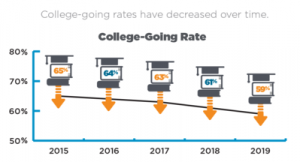
The impact of the COVID-19 pandemic on Indiana’s college-going rate is not measured in the 2021 College Readiness Report, as the new data is for the graduating high school class of 2019. With a known decrease in fall 2020 enrollment for two- and four-year colleges, the Commission anticipates the next readiness report could show continued decline.
One bright spot in Indiana’s college-going story: 21st Century Scholars’ college-going rate improved 2 percentage points to 88 percent. Scholars go to college at higher rates than their low-income (35 percent) and higher-income peers (64 percent) and are the only group on track to close Indiana’s college-going equity gap. “We cannot overlook the persistent questioning of the value of higher education as a factor in Indiana’s college-going decline,” said Indiana Commissioner for Higher Education Teresa Lubbers. “Hoosiers with education beyond high school were less likely to be unemployed in the aftermath of the economic upheaval that took place last year. Our challenge and opportunity must focus on increasing the higher education value proposition to Hoosiers, while ensuring students are ready and able to access it.”
“The 21st Century Scholars program continues to be an example of how aspiration and preparation, coupled with the state’s commitment to ensuring that students can afford to go to college, closes access and achievement gaps for low-income students,” Lubbers said.
Rise in graduation waivers cause for further investigation
The report also highlights an increase in graduation waivers awarded to 2019 high school graduates: Nearly 1 in 8 high school graduates were awarded graduation waivers in 2019, an increase of more than 3 percentage points in one year and the highest number in at least 15 years.
Graduation waivers are awarded to students who cannot pass Indiana’s requirements for graduating high school. While there are identifiable reasons for a waiver diploma, the increase is cause for concern. A possible factor in the one-year change: 2019 graduates were the first students required to pass Indiana’s ISTEP test in 10th grade, instead of the previous requirement of passing an end-of-course assessment. More changes in high school graduation requirements, including the transition to the SAT for state and federal accountability, will take place in the next few years as Indiana moves toward Graduation Pathways.
Data in the Commission’s Readiness Report show high school graduates who earned a waiver are less likely to enroll in college (only 28 percent of students who graduate with a waiver enroll in college) and less likely to be successful in college than students who were not awarded waivers. There is also disparity in which students are awarded waivers: students of color, low-income students and general diploma earners are more likely to graduate high school with a waiver.
“Graduation waivers serve a critical function for students who face certain barriers to completing high school, but it is important that we keep a high graduation standard in place for all Hoosier students,” said Indiana Secretary of Education Dr. Katie Jenner.
Additional report findings:
- Students who earn the Academic Honors diploma are more likely to go to college. Almost 90 percent of students who earn the Academic Honors Diploma go to college, compared to 46 percent of Core 40 earners and 14 percent of general diploma earners.
- There are gaps in college-going rates, depending on a student’s background. College-going gaps occurred—or widened in 2019—for students of color, those from low-income households, men and rural students when compared to the statewide average.
- Student performance is improving. Of the Commission’s metrics for early success in college (not needing remediation, persisting to the second year and completing all credits attempted), data show remediation remained low in 2019 (9 percent) and more students persisted and completed their attempted credits.
- More students are seeking shorter-term credentials. The percentage of students seeking a shorter-term credential (less than a two- or four-year degree) in 2019 more than doubled from the previous year (1.5 percent in 2018; 3.3 percent in 2019).
“Our charge is to ensure every student has access to the knowledge and experiences necessary to succeed in life and in their career,” said Jenner. “Across Indiana, our K-12 schools are partnering with institutions of higher education, as well as leaders in business and industry, to provide intentional, future-focused pathways and opportunities for students. These opportunities are critical to increasing Indiana’s college going-rate and, in turn, improving our students’ lifelong trajectory.”
Opportunities to improve college-going rates
The Commission regularly offers recommendations to accompany its data reports, which are supported by the strategies and action items outlined in its strategic plan Reaching Higher in a State of Change. The plan is Indiana’s roadmap to reach its big goal of at least 60 percent of Hoosiers with education and training beyond high school by 2025. Recommendations in the Readiness Report include:
- Ensuring Hoosier students find the right educational fit for their goals
- Emphasizing supportive programs like the 21st Century Scholars program to help close college-going equity gaps
- Providing stronger data for schools, policymakers, students and families
- Encouraging transparency at the high school level about where students can earn early college credit and increasing the number of high school students who graduate with the Indiana College Core
- Strengthening the educator pipeline
- Increasing FAFSA filing rates in Indiana, particularly for low-income students
